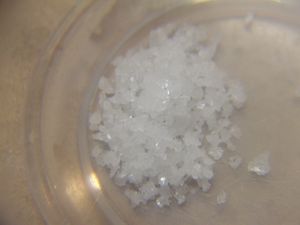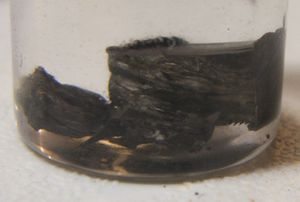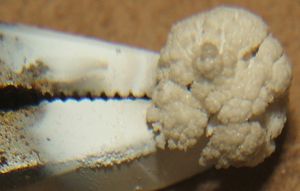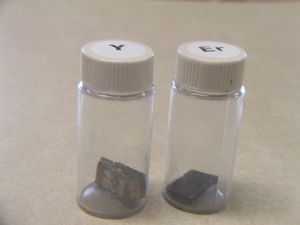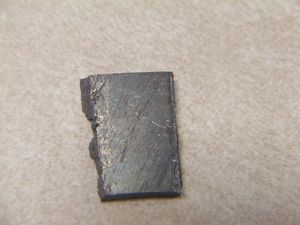WARNING: THIS ARTICLE IS EXHAUSTIVE AND THEREFORE MONOTONOUS. PROCEED WITH SPEED.
In this article I will describe the history of my personal experiences with chemistry. My extracurricular study of chemistry has covered much ground since I started performing experiments about four years ago. Like many people, my very first experiments involved kitchen chemistry. Strangely, I never performed any kitchen chemistry reactions until my teenage years. Before that, I only read about chemistry. Obtaining chemicals of any form always seemed like a distant fantasy, so I contented myself with reading science books and dreaming about myself as a scientist. Using these books, I learned about the periodic table and memorized many of the elements and their properties and uses. In one of the books, I noticed a description for a homemade hydrogen generator and became fascinated by it. Producing my own flammable “helium” balloons from scrap metal and a common acid had to be magic. However, we did not have chemicals such as muriatic acid and zinc strips, so I could only theorize. This was tacitly encouraged by my parents, who like all parents did not want me hurting myself with caustic chemicals but did not mind me spending all of my free time studying and learning. However, I had become curious, and it is hard to stop a curious child.
I accidentally discovered a chemical reaction; baking powder fizzes when mixed with water. This fascinated me, as I had believed that chemical reactions can only be performed in labs and that they were all dangerous. I wanted to step it up a little, though. I had heard much about the reaction between baking soda and vinegar from science books and decided to try that. I was even more surprised at the reaction than I was at the previous reaction, but, illustrating my current chemophobia, I still believed that the resulting product, sodium acetate, was toxic because it did not have a household name. I assumed at that time that I had completed all of the reactions possible with household substances as my parents told me that everything else was too dangerous to play with.
To increase my chemical knowledge, I began searching Encarta® Encyclopedia for chemicals. The small amount of information present about chemistry only made me search harder than ever, so I then decided to search online for random chemical compounds that I saw in textbooks. I soon found that Wikipedia was almost always the top result in these searches. I decided to check out the extent of Wikipedia’s chemical information and was dumbfounded by the number and size of the articles on chemicals and chemistry. For several months after this, most of my free time was spent taking painstaking notes from Wikipedia chemical articles and learning as much as I could about the few chemicals and elements I knew. I filled several notebooks with chemical information, drawings, and data about basic inorganic compounds and elements. Despite being able to find excellent data on the chemicals, these articles only described laboratory methods of synthesis, so I still did not have an idea on how to make any of these mysterious substances which were so different from the materials I had seen all of my life. Because I was planning to take chemistry in my junior year, I had purchased a chemistry textbook. To further increase my knowledge, I thoroughly perused that book, reading through it about a dozen times. Because I read the book so many times before taking the course to glean every bit of chemical information I could get, I got almost a perfect A+ with practically zero effort. That was only the beginning of the rewards I got for pursuing amateur chemistry as a hobby.
My introduction to genuine chemistry experimentation itself was gradual. I became fascinated with electrolysis over time. Since I heard only water and electricity were necessary to obtain an explosive mixture of gases (including hydrogen, my earlier dream), I decided to give it a try. I was disappointed with the performance of pure water. Even at 24 volts DC, the electrolysis occurred so slowly that I could hardly notice anything. I then read that electrolytes could be used to speed up the reaction. I added vinegar and used longer copper electrodes to provide more surface area. A green coloration appeared in the solution and bubbling was happening quite rapidly. The solution heated up and the smell of vinegar became strong. I added salt and the reaction improved even more. However, I noticed that all of the gas was being produced at the negative electrode while nothing but green slime was being made at the positive electrode. This colorful slime got the attention of my sister, who began a course of electrolysis experiments on her own. She used salt and copper and got “yellow water” (microcrystalline copper(I) oxide), while baking soda and copper got “green water” (basic copper carbonate), and Epsom salts and copper got “blue water,” (copper sulfate) named because of the colors produced. I became curious as to the composition of the precipitates/solutions and how they were formed. I then discovered that iron makes a green-gray precipitate which turns brown over time, and this metastable substance only made me more interested. A science kit I received as a gift required copper sulfate for most of the experiments in the chemistry section, and I was desperately looking for a source of this material. When I tried to form “blue water” and obtained a white precipitate at the cathode, I decided to research this reaction. I discovered that magnesium hydroxide was being formed, and the magnesium was being replaced in solution by copper. The solution turned bright blue and I stopped the electrolysis only when copper was falling out at the cathode as fast as it was dissolving at the anode. Upon evaporation, I got a blue solid that turned green on exposure to air (it lost some of its pentahydrate). I performed some experiments with this copper sulfate but was somewhat disappointed that it was only about 15% pure. Another more successful experiment I did was the heating of sodium bicarbonate to obtain sodium carbonate, also in the science kit’s chemistry section. This was done in a kitchen pot which was blackened on the outside much to my mother’s disapproval, although I kept trying to persuade her that the pot was fine for cooking. This began my synthesis craze.
I continued expanding my Wikipedia research and performing new syntheses of compounds. I electrolyzed iron in Epsom salts to form iron(III) sulfate. I electrolyzed lime in water and nothing happened. I also began finding more household sources of chemicals. I extracted potassium hydroxide from an alkaline battery and (unknowingly) converted it to potassium carbonate by long standing in air. I created sodium hydroxide from the chloralkali process and zinc acetate with modern pennies and vinegar. I formed copper(II) oxide by electrolyzing copper in sodium bicarbonate solution and heating the precipitate formed, although I did not know what to use it for. My room was constantly filled with new experiments almost exclusively in the aqueous state. Because I had no source of fire, my only way to form crystals was to evaporate in an open pan. This made my bedroom a very humid place, filled with all kinds of strange metallic smells. This caused my parents to relocate my chemistry lab in the basement, where I realized that storing chemicals in the individual compartments of an egg carton (my portable chemical shelf at the time) is inferior to storing them in closed paint mixing containers. However, I still had only a small amount of starting point chemicals. Then came my first glimpse of a genuine chemistry kit.
My pastor had an old chemistry kit belonging to his son and kindly donated it to me. The kit was designed for a middle-school scientist and being a junior in high school I found the experiments themselves quite uninteresting. The chemicals, however, were a completely different story. Chemicals that I have never heard of – phenolphthalein, protease, and copper(II) chloride – as well as those that I have read about but never expected to see until college – cobalt chloride, copper sulfate, zinc sulfate, silver nitrate, ammonium chloride – I now had in my possession. I began to do a huge array of experiments involving these new chemicals, wasting most of them. Suddenly, formerly abstract reactions from Wikipedia became intriguing realities as I continued to explore the wonderful world of chemistry. A significant number of glassware also came with the kit, which turned out to be the most useful portion of it. I still lacked many basic chemicals, but finally a school project gave an excuse to purchase them.
Due to my chemistry craze, it is no wonder that I decided to use chemistry for my science project, which was entitled “The Catalytic Decomposition of Hydrogen Peroxide.” I prepared a huge list of catalysts that would be mixed in equal weights (if possible) with a fixed volume of hydrogen peroxide. The oxygen production after a certain length of time is measured and recorded and the results compared. I intentionally added certain catalysts such as tincture of iodine, ammonia, and muriatic acid for the dual purpose of observing their catalytic effects and adding such valuable reagents to my chemical stockpile. The science project was a success, with several general trends visible on the periodic table and a whole new host of experiments opened to me. I was finally able to perform the cobalt chloride equilibrium with hydrochloric acid in my textbook and numerous other experiments, as well as restock critically low chemicals like copper(II) chloride (by dissolving CuO in HCl). These colorful and wonderful reactions made me think of using my camera to begin recording reactions. My first pictures were poor quality, but they steadily increased in quality as I learned how to take macro pictures. I then got a new camera and began taking videos as well as high-resolution pictures. Some of my first photographs were of flame tests, which were done on my parents’ old but only kitchen stove. I remember promising myself never to burn lead powder on the kitchen stove anymore as it produces a spectacular grayish flame but toxic red smoke. However, the only reactions I knew were only the ones that I stumbled upon or found on Wikipedia. Therefore, I did not know how to dissolve metals like lead, as I never suspected a 1 M solution of a very weak acid like vinegar to dissolve a relatively inert metal like lead with any reasonable speed. I heard the Romans had to wait months for their lead pots full of vinegar to accumulate enough atmospheric oxygen to produce a significant amount of lead acetate, which they used as a calorie-free sweetener. However, there were many metals that I could dissolve, many precipitates and complexes to be formed, and many mysteries to be sorted out with the unknown compositions of impure household products like magnets.
Ever since, I have expanded my range of experiments steadily. I found the wonderful forum Sciencemadness, and discovered a whole world of amateur experimentalists who have created processes for synthesis that were designed for chemists like me. For example, using some of this newly found information, I purchased bismuth and dissolved it in hydrochloric acid and hydrogen peroxide. I was quite happy to finally have bismuth chloride from which I could do the hydrolysis experiment featured in my chemistry textbook. I also extracted lithium (my first sight of a metal more reactive than aluminium) from a lithium battery and reacted it with water. I also found W. Oelen’s great site, which has a large number of riveting experiments, complete with high-quality videos and stunning photographs. I discovered how to dissolve lead (hydrogen peroxide and acetic acid) and did several experiments with it. The iodide of lead was an especially intriguing compound. (You can see some of my experiments on the YouTube channel LanthanumK or on this blog.) I also found out that placing a magnifying glass in front of my camera lens while taking photos drastically increases the quality and zoom level of the picture or video. I use this tactic for most all of my macro shots now. But all of my experiments have not been good.
I have gotten several temporary bans and restrictions on my experimentation due to chemistry epic fails. I electrolyzed tincture of iodine in my room, and the heat of the electrolysis evaporated much of the iodine and filled my room with fumes of iodine when I was sleeping. I woke up the next morning with a headache and a foggy feeling. That resulted in my chemistry being relocated again to the lower level of the house as it had gradually shifted back into my bedroom. Halogen strike one. Once I placed the manganese dioxide from a dead battery in hydrochloric acid. Very little chlorine was released, and it was barely noticeable in the indoor environment. Incorrectly deducing that a dead alkaline battery equals a charged one, I placed the manganese dioxide from a charged battery in hydrochloric acid in my mother’s hobby room (where I did my chemical experiments at the time) and filled the room with chlorine gas. Unfortunately it was my mother who walked in before me and got an unpleasantly strong but not suffocating whiff of chlorine gas. The solution was placed on top of a white surface, which was covered with black manganese dioxide stains after that due to splattering during the reaction. This resulted in a several-month break, my halogen strike two. Then I made some bromine water with bleach, sodium bromide, and hydrochloric acid, and poured it down a sink drain without dilution after some experiments. My sister bent over the sink and got a whiff of bromine vapors that allegedly gave her a headache. This was halogen strike three. I now respected the halogens much more than I previously did. Fortunately, my parents did not know that I made the same error, releasing halogen vapors indoors, three times in a row. I hope I get to work with fluorine someday, as this is the most fascinating of the halogens. Another time I drilled a hole in a lithium battery extracted from an EZ-Pass device. I should have researched why the battery voltage was 3.6 V instead of 3.0 V (like a normal lithium – manganese dioxide battery) before opening. Anyway, I drilled out the center carbon electrode and removed a smoking drill bit along with a smell of burning matches. I thought that I had caused a short and that the battery would catch on fire and explode or some bad thing, so I dunked it in water (bad move with any lithium battery). Fortunately, only a small amount of thionyl chloride – yes, this was a lithium thionyl chloride battery – could leak out at a time, but I still ended up stinking up my parents’ kitchen with a sulfur dioxide / hydrogen sulfide smell. After this, I decided to dismantle a partially charged nickel metal-hydride battery. I peeled back the coating without shorting out the jelly roll and took out the electrode materials, placing them on a metallic surface. This metallic surface was both my saving and my undoing. What happened was partly due to the metallic surface forming a short, aerial oxidation of the hydride material, and improper contact of the electrodes. I was busy somewhere else in the room when I noticed a light coming from the battery and looked up just in time to notice the battery igniting. Not knowing what would happen if the battery was allowed to burn, I immediately smothered it with a metal case of drill bits. (Out of the two more NiMH batteries I opened, two of them ignited upon opening as well.) Due to these types of experiments, my chemical lab ended up in the garage, where I accidentally vaporized some selenium and filled the garage with a fecal smell that I was sure was toxic. Heating the deposited selenium on the floor in an attempt to vaporize it did not help matters. This did not result in a ban as I was able to clean it up with bleach, a selenium oxidizer that can handle gray as well as red selenium. Another time I wanted to see whether the sodium atoms from celery would be visible in a flame test and filled the kitchen with a horrible smell of burning celery, which caused my parents to strongly discourage my use of the kitchen stove.
During one of these bans I wondered how many pure elements I had. I counted quite a few that I had on hand and quite a few that I was sure I could make. Thus began my element collection. I rigorously searched household materials for elements until I accumulated about 50 of them, then began purchasing and isolating a few. I have spent about 80 dollars on elements so far, mostly from Gallium Source. Contact me and I will give you my 90-page description of my element collection. You could also check in the archives of this blog for articles on how to obtain elements. I will give you tips and tricks on how to obtain individual elements if you ask me.
I decided to begin posting my experiments online on this blog to gauge reader’s responses and interest. I got a significant number of page views (over ten thousand so far), much more than I got for a generic blog that I also worked on. For a while I was posting two articles a day, but declined lately due to work and school. I am trying to work on posts when I get the time and hope to be coming out with more posts in the future.
I learned several lessons over my years in chemistry. One is “research before reacting”. A well-informed chemist can make split-second decisions regarding a runaway reaction or a smelly one without having to worry about uncertainty. When my sodium bromate reacted with hydrochloric acid to produce a cloud of brown bromine fumes, I immediately took it outdoors because I followed this rule. Another would be to regard other people’s noses. That acrid smell that you may not find annoying may irritate other people, and that is not an option. A third would be to use small quantities of reagents at first. Using large amounts of chemicals and accidentally contaminating or hydrolyzing it can be one of the biggest disappointments, especially if the chemicals were expensive.
I hope my readers learn something from this rehearsal of my experimental history. Be sure to stay safe but not sanitized. Experimental chemistry needs a touch of the unknown, puzzling, beautiful, dazzling, and even the noisy to be an interesting hobby for most ages. It cannot be a computer simulation, no matter how good they are. For me, it has guided me in the easy choice of a major, aced me through several classes, saved much study time, given me inspiration for my blog and YouTube channel, and decided the way I have spent much of my free time. Enjoy studying the building blocks of the universe at your desired level.
